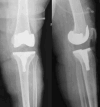SHORT-TERM EVALUATION BETWEEN POLYETHYLENE THICKNESS IN PRIMARY TOTAL KNEE ARTHROPLASTY
- PMID: 39086845
- PMCID: PMC11288312
- DOI: 10.1590/1413-785220243203e276755
SHORT-TERM EVALUATION BETWEEN POLYETHYLENE THICKNESS IN PRIMARY TOTAL KNEE ARTHROPLASTY
Abstract
Objective: The objective of the research was to carry out a comparative study between Smith & Nephew ® or Zimmer ® prostheses with thick versus thin polyethylene, in patients undergoing primary total knee arthroplasty, during a short-term follow-up. Thus, the objective was to analyze the survival of the implants in question under the clinical and radiographic aspect.
Methods: The sample was divided into two groups: Group 1 with thick polyethylene and group 2 with thin polyethylene. A clinical analysis of the patients was carried out and the implants were checked for loosening.
Results: The groups were similar when compared. According to the Ahlbäck classification, 83% of the patients were in groups IV and V. The median functional score in the postoperative period was similar between the two groups. Postoperatively, the tibiofemoral angle fluctuated between 5 and 6 0 valgus on average. Two complications were observed in each group. None of the evaluated patients presented implant loosening.
Conclusion: Patients treated with thick polyethylene had the same functional score as the control group, as well as the absence of radiographic changes in this short-term follow-up, with implant survival and a similar rate of complications between both groups. Level of evidence III, Retrospective study.
Objetivo: O objetivo desta pesquisa foi realizar um estudo comparativo entre as próteses Smith & Nephew ® e Zimmer ®, com polietileno espesso versus o fino, em pacientes submetidos à artroplastia total primária do joelho, durante um seguimento de curto prazo. Dessa forma, foi analisada a sobrevida dos implantes em questão sob o aspecto clínico e radiográfico.
Métodos: A amostra foi dividida em dois grupos: grupo 1 com polietileno espesso e grupo 2 com polietileno fino. Foi realizada análise clínica dos pacientes e verificado se ocorreu soltura dos implantes.
Resultados: Os grupos tiveram resultados semelhantes quando comparados. Segundo a classificação de Ahlbäck, 83% dos pacientes eram dos grupos IV e V. A mediana do escore funcional no pós-operatório foi similar entre os grupos. No pós-operatório o ângulo tíbio-femoral oscilou na média entre 5 e 6 0 de valgo. Foram observadas duas complicações em cada grupo. Nenhum dos pacientes avaliados apresentou soltura do implante.
Conclusão: Os pacientes tratados com o polietileno espesso apresentaram o mesmo escore funcional do grupo controle, assim como ausência de alterações radiográficas nesse seguimento de curto prazo, com sobrevida do implante e índice de complicações similar entre ambos os grupos. Nível de evidência III, Estudo retrospectivo.
Keywords: Joelho; Knee Arthroplasty; Prosthesis Failure.
Conflict of interest statement
All authors declare no potential conflict of interest related to this article.
Figures
References
-
- Jämsen E., Jäntti P., Puolakka T., Eskelinen A. Primary knee replacement for primary osteoarthritis in the aged: gender differences in epidemiology and preoperative clinical state. Aging Clin Exp Res. 2012;24(6):691–8. - PubMed
-
- Edwards S. A., Pandit H. G., Ramos J. L., Grover M. L. Analysis of polyethylene thickness of tibial components in total knee replacement. J Bone Joint Surg Am. 2002;84(6):369–71. - PubMed
-
- Kuster M. S., Stachowiak G. W. Factors affecting polyethylene wear in total knee arthroplasty. Orthopedics. 2002;25(Suppl 2):s235–42. - PubMed
LinkOut - more resources
Full Text Sources


